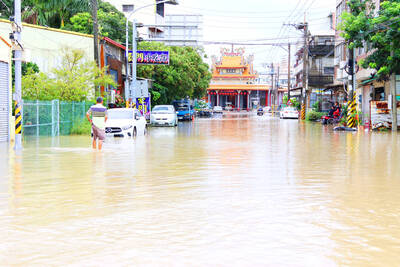South Korea yesterday announced a record 28.9 trillion won (US$20.9 billion) extra budget aimed at pulling the country back from the brink of its first recession in 11 years.
The Strategy and Finance Ministry said the budget — twice the size of extra spending during the 1998 Asian economic crisis — will save and create jobs, support small businesses, invest in new growth engines and help the poor and the jobless.
The ministry said in a statement that the budget, to be submitted to parliament this month, “puts priority on overcoming the economic crisis early.”
The export-driven economy has been hard hit by the global slump as overseas markets shrink. It declined 5.6 percent quarter-on-quarter in October to December, the steepest fall since 1998.
South Korean Finance Minister Yoon Jeung-hyun has said the economy will likely contract 2 percent this year and lose 200,000 jobs, while many private researchers expect a much steeper downturn.
The extra spending is equivalent to about 2 percent of GDP. It is expected to boost growth by 1.5 percentage points, the ministry said.
“The global economic downturn is taking place at a faster pace than expected in terms of its depth and breadth,” Yoon told reporters after the Cabinet approved the extra spending.
“Reflecting changed economic conditions at home and abroad, the government decided to draw up this extra budget to overcome the current crisis as quickly as possible,” he said.
Some 3.5 trillion won will be used to save and create jobs, including job-sharing schemes, the ministry said. The aim is to create 552,000 jobs in addition to those saved.
The number of people employed fell last month by 142,000 year-on-year, the largest reduction since September 2003.
Some 4.5 trillion won will go to support small and medium-size firms.
The budget sets aside 3 trillion won to reinvigorate the regional economy. Some 2.5 trillion will be invested in improving advanced education and in new growth engines — such as the government’s “green new deal” spending on environmentally friendly technology and projects.
The sum of 4.2 trillion won has been set aside to help low-income and jobless people.
The new spending totals 17.7 trillion won. The remaining 11.2 trillion won will largely be used to fund previously announced projects and tax cuts.

WAITING GAME: The US has so far only offered a ‘best rate tariff,’ which officials assume is about 15 percent, the same as Japan, a person familiar with the matter said Taiwan and the US have completed “technical consultations” regarding tariffs and a finalized rate is expected to be released soon, Executive Yuan spokeswoman Michelle Lee (李慧芝) told a news conference yesterday, as a 90-day pause on US President Donald Trump’s “reciprocal” tariffs is set to expire today. The two countries have reached a “certain degree of consensus” on issues such as tariffs, nontariff trade barriers, trade facilitation, supply chain resilience and economic security, Lee said. They also discussed opportunities for cooperation, investment and procurement, she said. A joint statement is still being negotiated and would be released once the US government has made

NEW GEAR: On top of the new Tien Kung IV air defense missiles, the military is expected to place orders for a new combat vehicle next year for delivery in 2028 Mass production of Tien Kung IV (Sky Bow IV) missiles is expected to start next year, with plans to order 122 pods, the Ministry of National Defense’s (MND) latest list of regulated military material showed. The document said that the armed forces would obtain 46 pods of the air defense missiles next year and 76 pods the year after that. The Tien Kung IV is designed to intercept cruise missiles and ballistic missiles to an altitude of 70km, compared with the 60km maximum altitude achieved by the Missile Segment Enhancement variant of PAC-3 systems. A defense source said yesterday that the number of

Taiwanese exports to the US are to be subject to a 20 percent tariff starting on Thursday next week, according to an executive order signed by US President Donald Trump yesterday. The 20 percent levy was the same as the tariffs imposed on Vietnam, Sri Lanka and Bangladesh by Trump. It was higher than the tariffs imposed on Japan, South Korea and the EU (15 percent), as well as those on the Philippines (19 percent). A Taiwan official with knowledge of the matter said it is a "phased" tariff rate, and negotiations would continue. "Once negotiations conclude, Taiwan will obtain a better

FLOOD RECOVERY: “Post-Typhoon Danas reconstruction special act” is expected to be approved on Thursday, the premier said, adding the flood control in affected areas would be prioritized About 200cm of rainfall fell in parts of southern Taiwan from Monday last week to 9am yesterday, the Central Weather Administration (CWA) said. Kaohsiung’s Taoyuan District (桃源) saw total rainfall of 2,205mm, while Pingtung County’s Sandimen Township (三地門) had 2,060.5mm and Tainan’s Nanhua District (南化) 1,833mm, according to CWA data. Meanwhile, Alishan (阿里山) in Chiayi County saw 1,688mm of accumulated rain and Yunlin County’s Caoling (草嶺) had 1,025mm. The Pingtung County Government said that 831 local residents have been pre-emptively evacuated from mountainous areas. A total of 576 are staying with relatives in low-lying areas, while the other 255 are in shelters. CWA forecaster